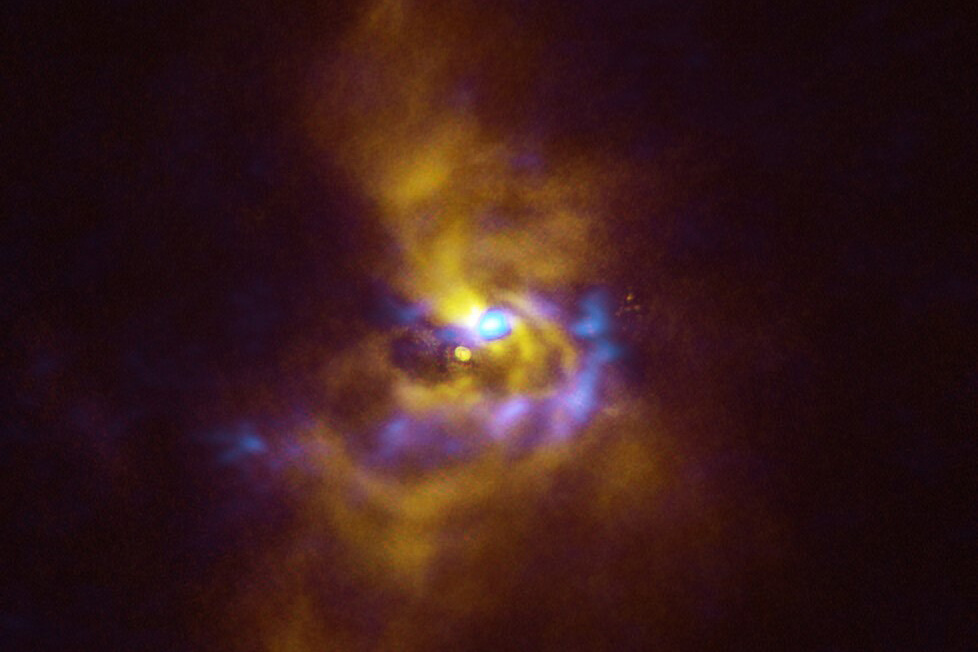RIT professor co-authors paper on new planetary formation findings
Joel Kastner contributes to discovery made by an international team through the European Southern Observatory
ESO/ALMA (ESO/NAOJ/NRAO/Weber et al.
This observation from the ESO’s VLT obtained by an international team that includes RIT professor Joel Kastner and RIT Ph.D. recipient David Principe shows the young star V960 Mon surrounded by dusty material orbiting the star and assembling into intricate spiral arms that have the potential to form planets.
Rochester Institute of Technology’s Joel Kastner, a professor in the Chester F. Carlson Center for Imaging Science and School of Physics and Astronomy, and a team of researchers with the European Southern Observatory (ESO) have discovered new evidence of how planets as massive as Jupiter can form, using images from the ESO’s Very Large Telescope (VLT) and the Atacama Large Millimeter/submillimeter Array (ALMA).
The combination of VLT and ALMA imaging have yielded detections of dusty clumps close to the young star V960 Mon that could collapse to create giant planets. The work is based on an infrared image obtained with the Spectro-Polarimetric High-contrast Exoplanet Research (SPHERE) instrument on ESO’s VLT and a radio-wavelength image with ALMA that together reveal, in fascinating detail, the material around the star.
This young star attracted astronomers’ attention when it suddenly increased its brightness more than 20 times in 2014. SPHERE observations taken shortly after the onset of this brightness “outburst” revealed that the material orbiting V960 Mon is assembling together in a series of intricate spiral arms extending over distances bigger than the entire solar system.
Kastner worked on the SPHERE imaging project with former RIT student David Principe ’14 Ph.D. (astrophysical sciences and technology), who is now at the Kavli Institute for Astrophysics and Space Research at the Massachusetts Institute of Technology.
“The two of us put SPHERE observing proposals together to look at these outbursting objects,” said Kastner. “We were hoping to see structure around them that is lit up by the outbursts, but we really weren’t sure what kind of structure we might see. We thought we might be able to see the dusty material around the star that is feeding the star and maybe forming planets, and this was a great case where both appear to have been detected.”
Astronomers believe that giant planets form either by “core accretion,”’ when dust grains slowly coagulate to form a massive core that sweeps up gas, or by “gravitational instability,” when large fragments of the material around a star quickly contract and collapse. While researchers have previously found evidence for the first of these scenarios, support for the latter has been scant. The images from VLT now show a real observation of gravitational instability happening at planetary scales.
“It’s a confirmation that one of the basic ideas of how planets form works,” said Kastner. “It’s a pretty good demonstration of what has been shown in very detailed simulations of discs around young stars to determine if they are making planets.”
The research team presented its findings in the July 25 issue of The Astrophysical Journal Letters. Authors span across the globe while the VLT and ALMA are located in Chile’s Atacama Desert.
The ESO enables scientists worldwide to discover the secrets of the universe for the benefit of all. Established as an intergovernmental organization in 1962, today ESO is supported by 16 member states (Austria, Belgium, the Czech Republic, Denmark, France, Finland, Germany, Ireland, Italy, the Netherlands, Poland, Portugal, Spain, Sweden, Switzerland, and the United Kingdom), along with the host state of Chile and with Australia as a strategic partner.
ALMA is an international astronomy facility in partnership with the ESO, the U.S. National Science Foundation (NSF), and the National Institutes of Natural Sciences (NINS) of Japan in cooperation with the Republic of Chile. ALMA is funded by ESO on behalf of its member states, by NSF in cooperation with the National Research Council of Canada (NRC), the National Science and Technology Council (NSTC) in Taiwan, and by NINS in cooperation with the Academia Sinica (AS) in Taiwan and the Korea Astronomy and Space Science Institute (KASI).
